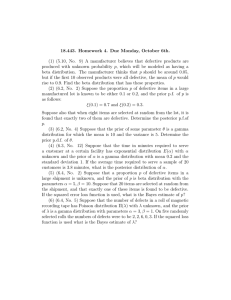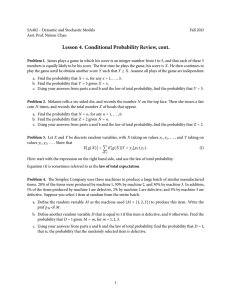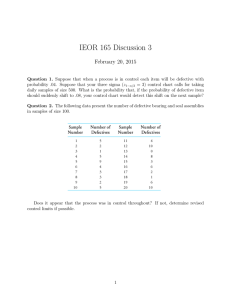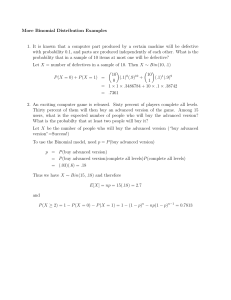Statistics Theory Exam - Master's Level
advertisement
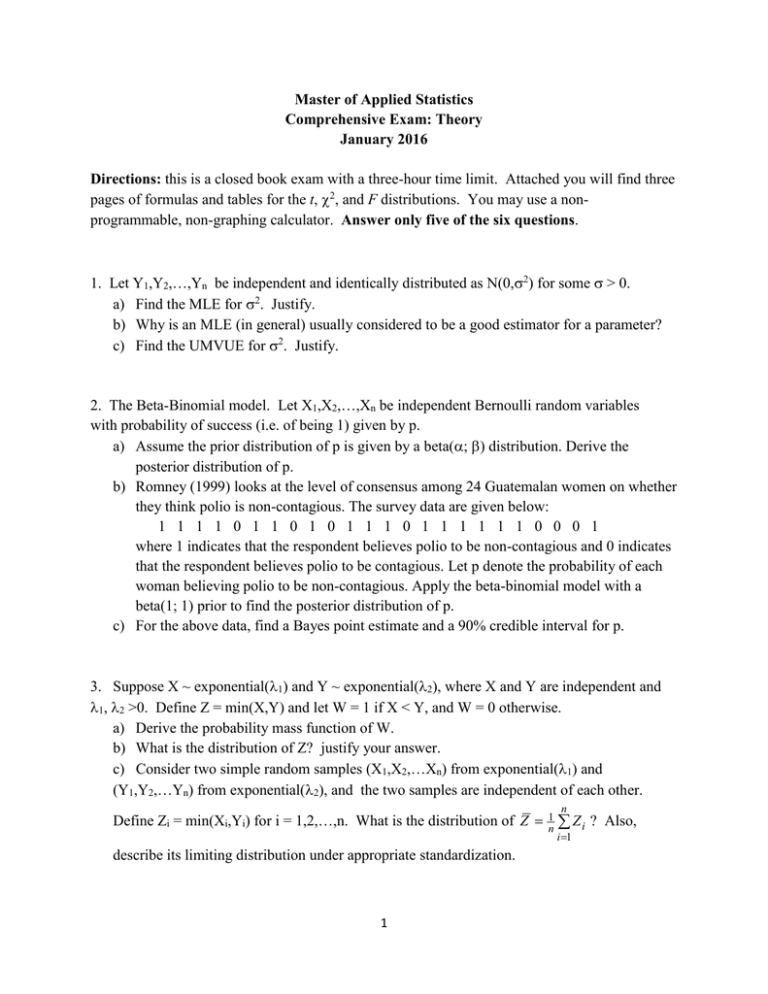
Master of Applied Statistics Comprehensive Exam: Theory January 2016 Directions: this is a closed book exam with a three-hour time limit. Attached you will find three pages of formulas and tables for the t, 2, and F distributions. You may use a nonprogrammable, non-graphing calculator. Answer only five of the six questions. 1. Let Y1,Y2,…,Yn be independent and identically distributed as N(0,2) for some > 0. a) Find the MLE for 2. Justify. b) Why is an MLE (in general) usually considered to be a good estimator for a parameter? c) Find the UMVUE for 2. Justify. 2. The Beta-Binomial model. Let X1,X2,…,Xn be independent Bernoulli random variables with probability of success (i.e. of being 1) given by p. a) Assume the prior distribution of p is given by a beta(; ) distribution. Derive the posterior distribution of p. b) Romney (1999) looks at the level of consensus among 24 Guatemalan women on whether they think polio is non-contagious. The survey data are given below: 1 1 1 1 0 1 1 0 1 0 1 1 1 0 1 1 1 1 1 1 0 0 0 1 where 1 indicates that the respondent believes polio to be non-contagious and 0 indicates that the respondent believes polio to be contagious. Let p denote the probability of each woman believing polio to be non-contagious. Apply the beta-binomial model with a beta(1; 1) prior to find the posterior distribution of p. c) For the above data, find a Bayes point estimate and a 90% credible interval for p. 3. Suppose X ~ exponential(1) and Y ~ exponential(2), where X and Y are independent and 1, 2 >0. Define Z = min(X,Y) and let W = 1 if X < Y, and W = 0 otherwise. a) Derive the probability mass function of W. b) What is the distribution of Z? justify your answer. c) Consider two simple random samples (X1,X2,…Xn) from exponential(1) and (Y1,Y2,…Yn) from exponential(2), and the two samples are independent of each other. n Define Zi = min(Xi,Yi) for i = 1,2,…,n. What is the distribution of Z 1n Z i ? Also, i 1 describe its limiting distribution under appropriate standardization. 1 4. A retailer buys items from a supplier; each item can be either acceptable or defective, and separate items are independent. a) Suppose the probability of each item being defective is 0.1. What is the probability that there are 6 defective items in a lot of 25? b) Suppose there are 6 defective items in a lot of 25. If 7 items are randomly sampled without replacement from the lot, what is the probability of finding no defective item among the 7 items? c) The lot will be unacceptable if more than 5 items are defective. Suppose the retailer selects randomly K items and decides to accept the lot if there is no defective item in the sample. How large does K have to be to ensure that the probability that the retailer accepts an unacceptable lot is less than 0.10? 5. Let Y1,Y2,…,Yn be independent and identically distributed as Poisson() for some >0. a) Show that the most powerful level- test of H0: =1 vs. Ha: =2 rejects H0 when Yi c for some c. b) Argue that your test from part (a) is UMP for testing H0: =1 vs. Ha: > 1. c) One can test H0: =0 vs. Ha: 0 for any choice of the GLR test rejects H0 if Yi c1 or Yi c2 for c1, c2 depending on 0 , , and n. Assuming that you have a computer program that can find c1 and c2 for every choice of 0, , and n. How might you construct a conservative 95% confidence region for given a value for Yi ? 6. Suppose X1 ~ gamma( 1, 1) and X2 ~ gamma(2, 1), where X1 and X2 are independent and 1, 2 > 0. Justify your answers to each of the following. a) Define V = X1 + X2. What is the distribution of V? b) Define U = X1/(X1 + X2). What is the distribution of U? c) What is the conditional distribution of U given V? 2
